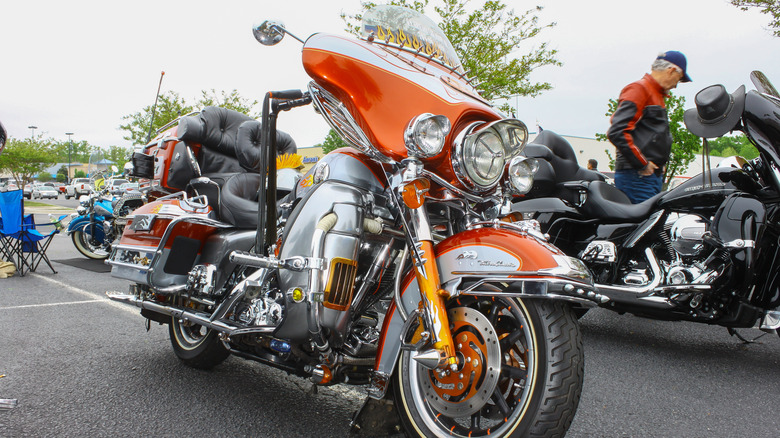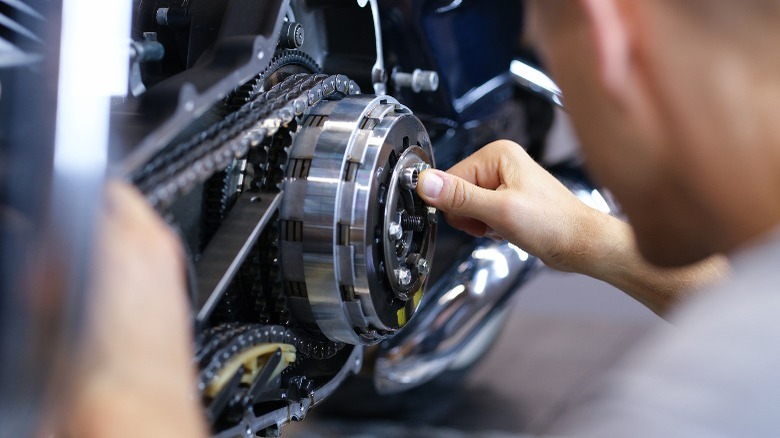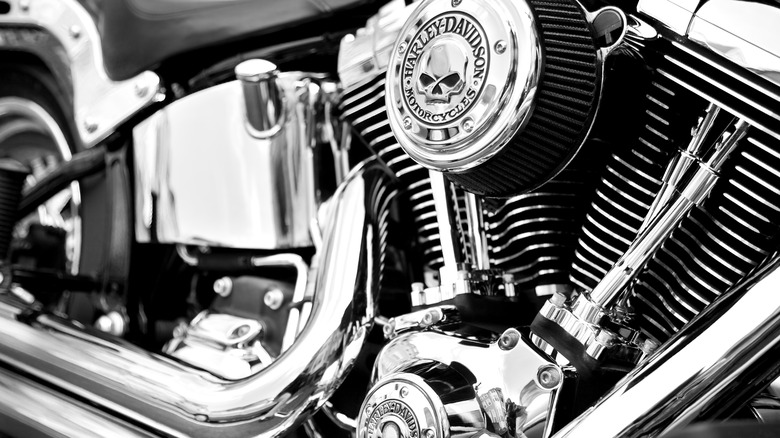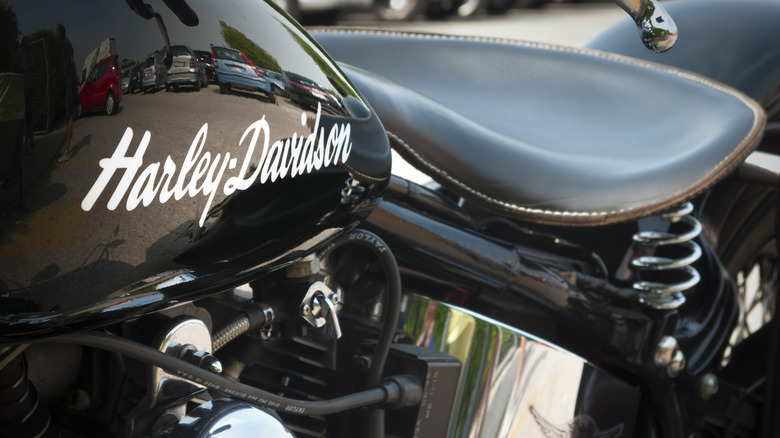Here's What Creates That Classic Harley-Davidson Sound (And Why It's So Unique)
Those who have driven a Harley-Davidson or simply seen one in action before have likely noticed that few other bikes out there sound quite the same as the storied motorcycle manufacturer's models. Indeed, Harley-Davidson motorcycles have long been known for their distinctive trademark sound — a sort of fast-paced, rhythmic clicking that follows a repeating "beat-beat-pause" pattern. As some might suspect, Harley-Davidson sounding different from the competition is no coincidence. In fact, it's a very major and intentional part of the brand's modern identity.
All of that said, some motorcycle fans may wonder exactly how nearly all Harley-Davidson bikes invariably manage to achieve that unique sound. The answer comes down to their engines, which feature a configuration that differs from most other bikes on the market in some key regards. Here's exactly what goes on under the hood of Harley-Davidson motorcycles and why it makes them sound so different from other brands.
Most motorcycles follow a specific engine configuration
In order to comprehend what Harley-Davidson motorcycles do to evoke their distinctive sound, one must first understand how other motorcycle engines and exhaust systems are typically configured. On a foundational level, Harley-Davidson engines mirror the functionality of any other major motorcycle engine, but the exact way that they achieve the end result is different.
Like many standard engines in automotives, the ones commonly found in typical motorcycle brands operate on an internal combustion cycle. Per an explanation from How Stuff Works, the process follows a four-stroke pattern. As the piston moves on the first stroke, the camshaft opens the intake value and allows gasoline and air to mix. On the second stroke, the piston moves back into place and compresses the gasoline and air. With the third stroke, the spark plug ignites the mixture and the resulting combustion pushes the piston back down. Finally, the fourth stroke involves the piston's movement opening the exhaust valve, allowing the exhaust to escape the unit.
Many standard motorcycles operate with a standard two-cylinder engine, in which there are two distinct pistons. These engines typically have a crankshaft that contains two distinct piston-connected pins that are diametrically opposed from one another, allowing both pistons to carry out the four-stroke cycle in lockstep with one another. The audible result is the consistent ticking of the exhaust valve, which consistently opens on a fixed and unchanging interval. Suffice to say, Harley-Davidson bikes generally do not operate with this exact sort of internal structure and, thus, an alternate sound is produced.
Harley-Davidsons have a very unique engine configuration
Even taking a cursory look at the distinctive external V-shape of the typical Harley-Davidson V-Twin engine is enough to alert most to the idea that this engine must function differently than other models — and that assumption would be exactly right. While Harley-Davidson engines generally follow the same combustion cycle as most other motorcycles in order to function, their internal structure is radically different.
Similar to the standard structure of a two-cylinder motorcycle engine, Harley-Davidson engines contain two pistons. However, unlike most other engines of its kind, these pistons do not fire at a singular fixed interval. The crankshaft only contains one pin for both pistons and its spark plugs are positioned at a 45-degree angle, owing to the V-shape of the engine. As a result, the two pistons have to wait for uneven intervals of time to fire. In practice, the process involves a single piston firing, the other piston having to wait for a 315-degree crankshaft rotation to fire, and the first piston subsequently waiting for a 405-degree rotation to fire again.
That all may sound pretty complicated, but the key factor to note is that it takes a bit longer for the first piston to repeat the cycle and fire again than it does for the second piston to fire after the first piston. That's why Harley-Davidson motorcycles' signature exhaust pop sound follows a syncopated "beat-beat-pause" pattern. The first two beats are the two pistons firing in quick succession, while the pause comes from the comparatively longer amount of time it takes for the first piston to start again.
Harley-Davidson tried to trademark its unique engine sound
As iconic as it may be, the signature engine sound of Harley-Davidson motorcycles was not a purposeful creation for the manufacturer. Rather, it was a byproduct of the company's experimentation with modifying its engine structure into the simplified and streamlined V-shape design fans love today. Despite the sound being something of an accidental invention, there was once a time when Harley-Davidson attempted to obtain legal ownership over it.
Back in 1994, Harley-Davidson unexpectedly filed an application to trademark the unique sound created by its V-Twin motorcycle engines. By this point, the sound and its corresponding engine design had been around for more than 80 years, but it had gone on to become such a major part of the Harley-Davidson brand identity that the motorcycle company believed it had grounds to obtain the exclusive rights. According to iMotorbike, the attempt prompted intense backlash from other major motorcycle manufacturers, who argued that the sound created by a typical V-Twin engine structure was not exclusive to Harley-Davidson's models.
Ultimately, the opposition to Harley-Davidson's case won out, as the official court ruling was that a sound was not enough of a functional element in a motorcycle to warrant a trademark. In 2000, Harley-Davidson dropped the matter entirely, leaving the syncopated engine sound free from any sort of exclusivity. That said, the sound is still most commonly associated with Harley-Davidson to this day. It also continues to stand as a core component in the design process of even the most powerful Harley-Davidson engines out there.



